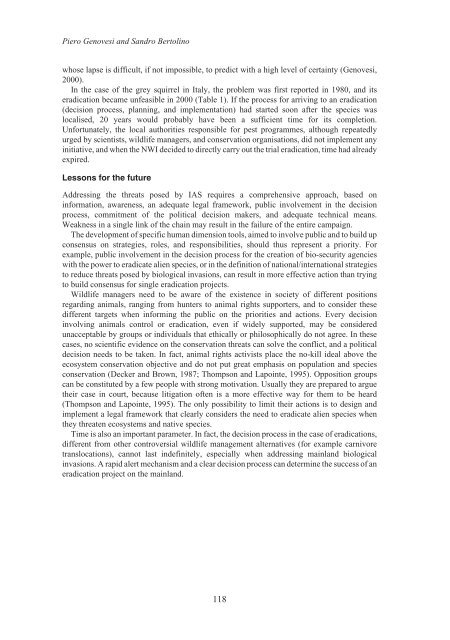Alien Species.vp - IUCN
Alien Species.vp - IUCN
Alien Species.vp - IUCN
Create successful ePaper yourself
Turn your PDF publications into a flip-book with our unique Google optimized e-Paper software.
Piero Genovesi and Sandro Bertolino<br />
whose lapse is difficult, if not impossible, to predict with a high level of certainty (Genovesi,<br />
2000).<br />
In the case of the grey squirrel in Italy, the problem was first reported in 1980, and its<br />
eradication became unfeasible in 2000 (Table 1). If the process for arriving to an eradication<br />
(decision process, planning, and implementation) had started soon after the species was<br />
localised, 20 years would probably have been a sufficient time for its completion.<br />
Unfortunately, the local authorities responsible for pest programmes, although repeatedly<br />
urged by scientists, wildlife managers, and conservation organisations, did not implement any<br />
initiative, and when the NWI decided to directly carry out the trial eradication, time had already<br />
expired.<br />
Lessons for the future<br />
Addressing the threats posed by IAS requires a comprehensive approach, based on<br />
information, awareness, an adequate legal framework, public involvement in the decision<br />
process, commitment of the political decision makers, and adequate technical means.<br />
Weakness in a single link of the chain may result in the failure of the entire campaign.<br />
The development of specific human dimension tools, aimed to involve public and to build up<br />
consensus on strategies, roles, and responsibilities, should thus represent a priority. For<br />
example, public involvement in the decision process for the creation of bio-security agencies<br />
with the power to eradicate alien species, or in the definition of national/international strategies<br />
to reduce threats posed by biological invasions, can result in more effective action than trying<br />
to build consensus for single eradication projects.<br />
Wildlife managers need to be aware of the existence in society of different positions<br />
regarding animals, ranging from hunters to animal rights supporters, and to consider these<br />
different targets when informing the public on the priorities and actions. Every decision<br />
involving animals control or eradication, even if widely supported, may be considered<br />
unacceptable by groups or individuals that ethically or philosophically do not agree. In these<br />
cases, no scientific evidence on the conservation threats can solve the conflict, and a political<br />
decision needs to be taken. In fact, animal rights activists place the no-kill ideal above the<br />
ecosystem conservation objective and do not put great emphasis on population and species<br />
conservation (Decker and Brown, 1987; Thompson and Lapointe, 1995). Opposition groups<br />
can be constituted by a few people with strong motivation. Usually they are prepared to argue<br />
their case in court, because litigation often is a more effective way for them to be heard<br />
(Thompson and Lapointe, 1995). The only possibility to limit their actions is to design and<br />
implement a legal framework that clearly considers the need to eradicate alien species when<br />
they threaten ecosystems and native species.<br />
Time is also an important parameter. In fact, the decision process in the case of eradications,<br />
different from other controversial wildlife management alternatives (for example carnivore<br />
translocations), cannot last indefinitely, especially when addressing mainland biological<br />
invasions. A rapid alert mechanism and a clear decision process can determine the success of an<br />
eradication project on the mainland.<br />
118












